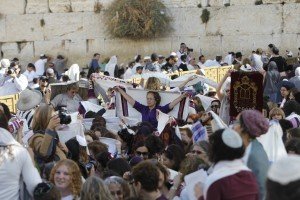 Women of the Wall, (Neshot Hakotel הכותל נשות in Hebrew) is a group of Jewish women from Israel and around the world who strive to achieve the right to wear prayer shawls, pray and read from the Torah collectively and out loud at the Western Wall (Kotel) in Jerusalem, Israel. The Western Wall is Judaism’s most sacred holy site and the principal symbol of Jewish peoplehood and sovereignty, and Women of the Wall works to make it a holy site where women can pray freely. Women of the Wall is comprised of women from all denominations of Judaism – Orthodox, Reform, Conservative, Masorti, Renewal and Reconstructionist.
Women of the Wall, (Neshot Hakotel הכותל נשות in Hebrew) is a group of Jewish women from Israel and around the world who strive to achieve the right to wear prayer shawls, pray and read from the Torah collectively and out loud at the Western Wall (Kotel) in Jerusalem, Israel. The Western Wall is Judaism’s most sacred holy site and the principal symbol of Jewish peoplehood and sovereignty, and Women of the Wall works to make it a holy site where women can pray freely. Women of the Wall is comprised of women from all denominations of Judaism – Orthodox, Reform, Conservative, Masorti, Renewal and Reconstructionist.
Women of the Wall not only seeks empowerment in group prayer and Torah reading at our most sacred site, but also strives for recognition of our prayer service by the legal and religious Israeli authorities, for the sake of all Jewish women. Our group, with a membership that is not only multi-denominational but spans the political spectrum, embodies a message of tolerance and pluralism.
To learn more, read our history, mission or send a request to meet with Women of the Wall.
Why Neshot Hakotel?
In Hebrew, the word for women is nashim. Since – im is generally a masculine plural ending and –ot is generally the feminine plural ending, nashim is an exception to the linguistic rule. We chose to use neshot, similar to the way second-wave American feminists have chosen to use womyn for woman and wimmin for women. It is a pro-female assertion that seeks to remove the linguistic dependency of the word woman or women on the word man or men, since unfortunately these female words have largely and historically been characterized as a derivative of the male, a statement with social implications.
Why the Kotel?
The Kotel is the only remaining wall left of the Second Temple- the place where our ancestors went to seek G-d. We aspire to do the same: with prayer, reverence, and joy. Freedom to worship at the KoteI is one of the most important outcomes of the Jewish people’s return to Jerusalem in 1967, but this great achievement is tainted by the fact that women are prohibited from praying freely at the holy site. The Kotel is a central symbol of Jewish unity to Jews around the world.
If, as tradition tells us, the Temple was destroyed because of sinat hinam – baseless hatred – we dare to assert that allowing our voices to be heard would be no less than a tikkun, a mending, of the history of intolerance.
For information about joining us for Rosh Hodesh, click here.
